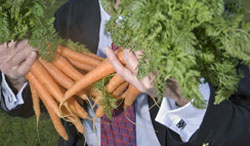
New SL567A trials in carrots have shown full-rate application whilst the crop is still at the one to two leaf stage provides the best season long control of cavity spot.
Carrot growers can achieve good levels of cavity spot control with SL567A, but application timing is crucial to get the best results. Recent research, conducted by Agrovista and Syngenta, has revealed that the application of a single full-rate dose at the one to two leaf stage is the best timing - and gave significantly better control than delayed applications, or a split-application of two half-doses.
Agrovista vegetable specialist, Peter Parr, reports the best results will be achieved when soils are damp at application. "But the most important factor is to get the timing right; within the first six weeks, and before the crop gets beyond the two leaf stage." In the trial - on heavily infected land, following a previously badly infected crop - a single application at the one to two leaf stage achieved a 50% reduction in infection at the end of October; a month's delay in application led to an 80% increase in cavity spot.
"Extending the crop rotation, selecting varieties with the highest natural resistance and early lifting can all help to minimise the incidence of cavity spot," advises Mr Parr. "In practice UK growers are limited in the varieties they can grow and have to supply fresh carrots all year round - it is infections on over-wintered crops that cause the greatest problem. Our increasingly mild winters appear to be encouraging cavity spot, and it is becoming increasingly difficult to control."
Previous trials have shown significant increases in marketable yield and top-grade pack-out from SL567A applications. On mineral soils up to 90% control has been observed and 80% on organic soils.
Syngenta Technical Manager, Jon Ogborn, warns the latest research indicates that Pythium violae - the pathogen primarily responsible for cavity spot infection - may be present at low levels in most soils. In-season weather conditions dictate how well the Pythium develops and infects the root hairs, which in turn leads to secondary infection and the characteristic symptoms of cavity spot.
"The 2006/07 season has been particularly bad for cavity spot," he reports. "Wet warm soils at the end of the season were highly conducive to the disease development on over-wintered crops.
"However, the trials have shown that SL567A is still effective in reducing the initial Pythium infection and remains an important part of the control programme. Our results indicate that early reduction of the pathogen population, with application at one to two true leaves, remains the most effective way to minimise damage," Mr Ogborn adds.
